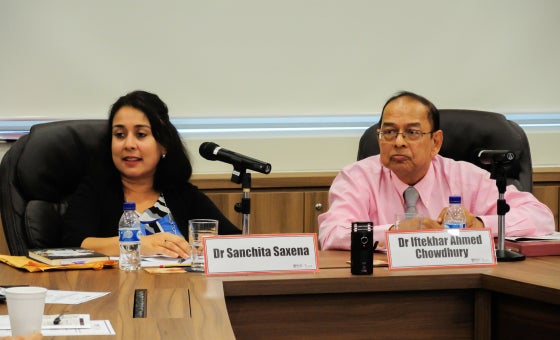
| Event Title: | Seminar |
| Topic: | Made in Bangladesh, Cambodia, and Sri Lanka: The Labor Behind the Global Garments and Textiles Industries |
| Date/Time: | 24 November 2014 | 00:00 - 02:37 |
| Venue: | ISAS Board Room |
| Speaker/s: | Ms Sanchita Saxena, Executive Director, Institute for South Asia Studies; Director, Chowdhury Center for Bangladesh Studies, UC Berkeley |
| Description: | The general perception of the garment and textile industry in the global South is fueled only by images of dismal labor conditions and unsuitable factories, descriptions of labor clashes with police, and analyses of low wages and exploitative multinational corporations. This book presents an insightful perspective on the garment and textiles industries in Asia by highlighting that an industry fraught with competing concerns can, in fact, collaborate and work together when it is in the interest of both the state and interest groups to do so. This comparative study recognizes the role of both the state and interest groups in the policy making process and argues that they are interlinked and require one another for sustainable reforms. Employing original, in-depth research in three different countries, the study skillfully delves down deep beyond the macro statistics and commonly held images to cast light on some of the significant policy and attitudinal shifts that have occurred in this industry. By analyzing the garment sector through the lens of domestic coalitions, Made in Bangladesh, Cambodia, and Sri Lanka: The Labor Behind the Global Garments and Textiles Industries presents new and innovative ways of conceptualizing the garment and textiles industries that include the possibility for change and resistance from a vantage point of cooperation among key groups, rather than only contention. Dr. Saxena has conducted more than a hundred interviews with key informants, several focus groups with eighty-five garment factory workers, as well as quantitative surveys of a hundred garment workers in Bangladesh, Cambodia, and Sri Lanka to establish several important insights about this early stage of domestic coalitions in these countries. First, the changing role of labor marked by its entrance into the coalition is itself significant in these countries where the network has been historically shut out to labor groups. Second, the study demonstrates that various types of channels and mechanisms, both institutionalized and non-institutionalized, are essential to ensure the representation of labor groups and their influence on policy change in the industry. Third, the book expertly delinks the concepts of ÔÇ£improved labor conditionsÔÇØ and ÔÇ£worker empowerment,ÔÇØ by arguing that one should not assume that better labor conditions automatically translate into an empowered workforce. Finally, Dr. Saxena comes to a critical conclusion that change and improvements stemming from top-down programs, though they may be initially effective in improving basic standards, do not help in furthering coalitions with labor groups and institutionalizing their role in policy making. This study puts the entire sector into the larger context of international trade policy; effects of decades of import quotas set the context at the beginning of the book while current trade policies impacting the garment sector, are discussed at the end. Dr. Saxena convincingly argues that the sector and the incentives of those who depend on it cannot be understood without this larger context in which the sector has flourished and ultimately survived, and all of these elements combined are essential to understanding the complexities of the garment and textile industries |


